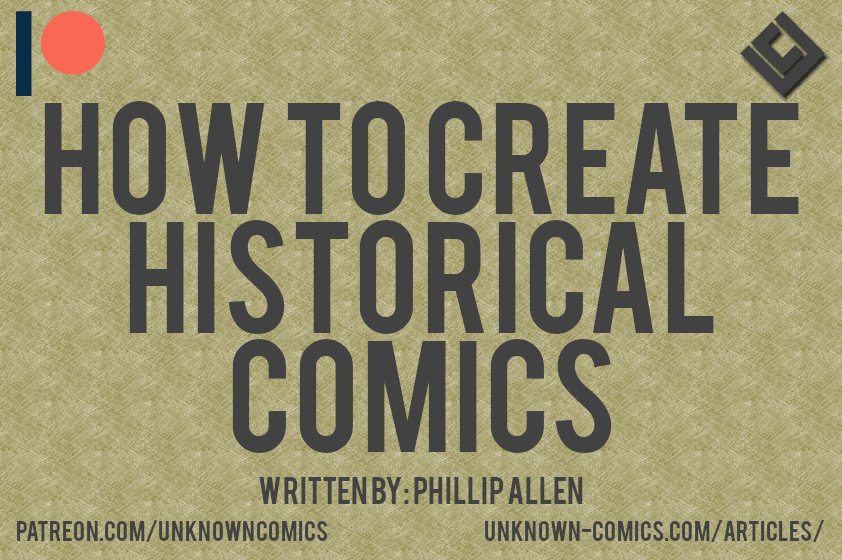It seems that the longer I write these articles, the more I feel like I get to write about topics that have piqued my interest for a long time. And talking about how to create historical comics is definitely up there on that list!
I wanted to take the time to discuss how comic creators can work to create a historical comic that can be accurate, emotionally engaging, inspiring, or at the very least interesting enough for readers to take the initiative and dive deeper into the topics that are integral to the history or references that you included in your comic.
With that in mind, I will be dedicating two articles to this topic. This article will focus on how comics can do a more impactful job of teaching people about history than other media, and what responsibility comic creators should take with their research. My next article will focus on how comic creators can focus on the depiction of the visuals, story, and characters in their work.
So, let’s get started!
How Historical Comics Can Do Better than Text, Art, And Photographs.
Comics can do quite a lot more for depicting history than many photos, art, and history texts can. As a comic creator, you understand that not only words can tell a story, at many a time, it is a combination of words and visuals that really leave an impact. You understand that it is one thing to write about war, peace, pestilence, advancement in technology, famine, and prosperity; and how it’s another to see people act due to or in spite of it.
Comics can present a still, yet moving depiction of the times that they are based on. Coldly and faithfully giving the readers the time to process what is on the page or panels that they are reading.
Only comics could show you the consequences of war, diplomacy, mass outbreaks of disease, the results of medical advancements, a lack of resources such as food and water, fair trade, and more in such a way that you are forced to not only see how it starts, but also see how others manage it, ignore it, or take advantage of it; all in the amount of time that it takes to read a few panels or pages.
In a comic, you can take the time to show the intricacies that happen behind the scenes surrounding the events in history like:
- Wars
- Major Diplomatic Disputes and Resolutions
- Mass Migration of Refugees
- Supply Chain Management
- Resource Management
- Troop Movement
- Weapons Development
- Technological Advancement
- Religion
- Sociological, Psychological, and Cultural Restraints
- And More
Even if some of these aspects are hinted at, it could add depth to your story in ways most original tales fail to do so. And in the following sections of this article, and in the next part, I’ll be touching on some key points of how you can do this.
Like the article so far? Support the production of more articles like this one!
How To Create Historical Comics
In short, there are three aspects that comic creators need to take into consideration before starting a new project. The visuals, the story, and the characters that they want to include. Fortunately, there are options available to make accurate, or engaging, creation of historical comics possible. I’ll be going into those options in more detail in the next article.
However, regardless of how much research you do for your historical comic, you may be forced to make some assumptions, especially when it comes to character dialogue, behavior, and internal thought process. There can be more that affects the accuracy in your work, which leads me to my next point.
What To Do With The Assumptions
If you collect the information necessary to develop a historical comic’s visuals, story, and characters, you will be ready to create a historical comic with a substantial amount of depth.
Some assumptions and liberties may be taken, but for the sake of accuracy, they should be taken note of and handled responsibly. Doing so will help to avoid tricking, confusing, or worse, making your readers believe that everything you’ve created is an undoubted fact.
I may not be the only one to have this opinion, but I do not believe that it is right how many historical texts and studies do not go out of their way to outline where they may have made some assumptions. They don’t go into detail about the potential inaccuracies behind their sources. I do believe that this is information should be made privy to students of history.
If I could take the time to request one thing from anyone reading this article, who then gets inspired to create historical comics, is to also create great resources outlining the problems with their research and their work. I am sure that more than one reader will appreciate the effort you’ve gone into researching for your comics, but also to teach them where you may have made up some things up and for what reasons you did.
You can do this by adding:
- Writer and editor notes.
- Adding in dialogue citations.
- Addling a bibliography to all your sources before and or after your comic.
- Creating a webpage where your readers can visit and read about where you made assumptions or where you feel or know your sources may be a bit unreliable.
Conclusion
Well, this part of this short article series sure went into the weeds when it came to background detail for trying to learn how to create historical comics.
However, I feel that it is important to understand the benefits that comics can bring to educational content like history, what a comic creator would have to research to be able to write and illustrate a faithful and accurate representation of history, or what they should do when they take liberties with available information when compiling their work.
I believe that after reading part 1 and part 2 of my series on how to create historical comics you will be ready to pick a topic and making an amazing comic based on an interesting point in history.
Sign Up For
The Unknown Times!
Content Updates
Website News
Recommended Reading
And More to Come!
*Once every two weeks!*
Liked the article? Become part of my Patreon Community!
About The Author

Phillip Allen
Writer, Editor, and Founder of Unknown Comics
Hello there! My name is Phillip Allen and I'm the writer, editor, and founder of Unknown Comics. I am an aspiring comic book creator. In an attempt to learn how to create my own comic I came to learn just how few reliable resources existed out there. From a few books and unhelpful websites I decided to focus my attention on researching and writing a resource for both myself and the rest of the comic creating industry. This website and and its content is the result of all of that hard work.

